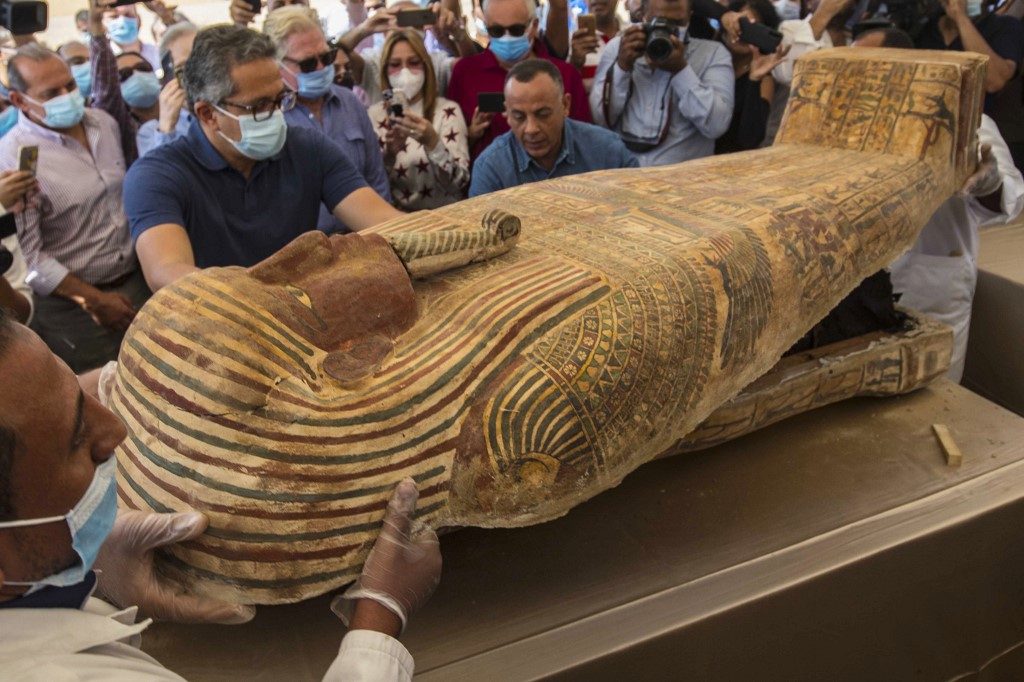Archaeologists in Egypt have made an exciting discovery in the Saqqara archaeological zone, unearthing a 2,500-year-old burial site that contains at least thirteen ancient burials. The wooden caskets were found stacked on top of each other in an enclosed burial well, which was approximately eleven meters deep. What makes this discovery particularly notable is the way in which the caskets were arranged, as well as the fact that some of the original colors have been preserved. Khaled Al-Anani, head of the Egyptian Ministry of Tourism and Antiquities, announced the find in a Facebook post, sparking fascination and excitement among archaeology enthusiasts worldwide.

Classified as a UNESCO World Heritage Site in 1979, Saqqara is located about 30 kilometers (19 mi) south of modern-day Cairo, and is an expansive ancient burial ground that once served as the royal necropolis for the prehistoric Egyptian capital of Memphis. The Saqqara cemetery is regarded as one of the most important archaeological areas in Egypt and is home to hundreds of elaborate royal tombs with walls blazoned in magnificently colorful inscriptions. Above ground the skyline is scattered with grand stone monuments to the gods including pyramids, temples, tombs, cult shrines and cemeteries.

Speaking with Egypt Independent , Egypt ’s Minister of Antiquities described the Saqqara cemetery as the only one in Egypt that “included tombs from the beginning of Egyptian history to its end, while also including many monuments from the Greek and Roman eras.” And it was here, buried deep below the royal ruins at Saqqara, archaeologists discovered the thirteen stacked human coffins.

Ancient Marvels of the Saqqara Otherworld
It would be folly for us to look at the individual tombs and monuments of the Saqqara desert necropolis and to try interpreting them as such. To really understand how this site functioned at its peak one must conceptualize the entire area as a dead-zone, a stone representation of the otherworld itself. When in operation, this vast archaeological site was not a representation of the afterlife, but when manned with thousands of priests engaged in 24/7-365 worship, it was the otherworld.

In December 2018 I wrote an article for Ancient Origins about the discovery of a colorful 4,400-year-old tomb, the Tomb of Wahty, which Mostafa Waziri, secretary general of the Supreme Council of Antiquities, described as “one of a kind in the last decades.” 365 ushabti statues , once for each day of the solar year, were found and some were inscribed with colorful hieroglyphics. Also found were small wooden obelisks surrounding a central wooden statue of the god Ptah . Furthermore, it was only in April 2020 that archaeologists at Saqqara discovered a sacred animal and bird cemetery containing hundreds of mummified creatures , including crocodiles, cobras, birds, cats, and more, said to have accompanied their owners on their voyage to the netherworld.

Egyptian Discoveries That Changed Archaeological History
Khaled Al-Anani says his team’s initial studies at the new burial site have indicated that the coffins were discovered completely sealed, meaning they have not been opened since being buried in the well more than 2,500 years ago and have luckily avoided the hands of treasure hunters, looters and black marketeers. He also says this discovery represents the “largest number of coffins in one burial since the discovery of the Al-Asasif cachette.”
Looking back to an October 2019 Ahram Online article, the Al-Asasif cachette was the discovery of “thirty intact, sealed and painted anthropoid coffins of a group of 22nd dynasty priests and priestesses of Luxor ’s deities Amun and Khonsu … unearthed in Asasif necropolis in Luxor.” At that time Tourism and Antiquities Minister Khaled El-Enany said: “This is the first cachette of coffins to be uncovered in Luxor since the end of the 19th century.”
Following the historical references given by Khaled El-Enany in 2019, the late 19th century discoveries he mentioned were made in Luxor, and included the 1881 haul of royal mummies at Al-Deir Al-Bahari, and king Amenhotep II’s tomb which was presented to the public with great pomp and ceremony in 1898. If one takes into account this historical context, the recent discovery of thirteen coffins at Saqqara is rubbing shoulders with some of the most significant discoveries in the history of Egyptian archaeology, and represents the central jewel in Egypt’s 2020 archaeological crown.







